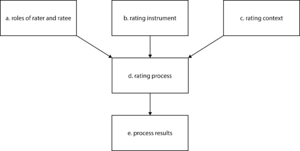Rating process
| Rating process |
|---|
| See also |
Rating process term stands for a technique which put under consideration factors such as presented risk, administrative constraints, benefits or demographic features. Usually, rating process is only a part of action which is focused on conducting deep analysis to make a relevant and as rational as possible decision based on some reasonable argumentation. In most cases rating process helps in right establishment of the premiums rate in performance rating or credit worthiness[1].
Using rating process in practise
On the example of the performance rating component model (Fig. 1), rating process is a part of whole rating system. It may include the following elements[2]:
- a. the roles of person responsible for observing and evaluating worker's performance (the rater) and worker under observation (ratee),
- b. the method of realizing rating,
- c. the situation and environment in which rating makes place such as organization structure, purpose of evaluation and motivation,
- d. the rating process, currently discussed element, used to analysis ratee performance and compare to concept of standard action taking into account specific features or administrative constraints or individual strategies of rater.
- e. the rating results such as planned actions or feedback about observed performance.
Using rating process in a specific situation can not only give deeper feedback but also might protect organization from wrong decision and minimize risk of making decisions[3]. In financial area of creditworthiness right rating process is crucial. Basic element of consideration include quantitative variables, for example cash flow establishment of potential obligor and his liquidity or qualitative variables such as competitive advantages or what is more important, competitive disadvantages[4]. However, scale of importance may be lower than financial decisions but this action is still valuable. Rating process also takes place in a bunch of method in assessment center for generating ratings[5]. It is all about gaining knowledge, which might be useful and provide development[6].
Footnotes
References
- Huhta, A., Alanen, R., Tarnanen, M., Martin, M., & Hirvelä, T. (2014). Assessing learners’ writing skills in a SLA study: Validating the rating process across tasks, scales and languages.. "Language Testing", 31(3), 307-328.
- Landy, F. J., & Farr, J. L. (1980). Performance rating. “Psychological bulletin”, 87(1), 72.
- Moses, J. L., & Byham, W. C. (Eds.). (2013)., Applying the Assessment Center Method, Elsevier, Amsterdam, s. 3
- Robie, C., Osburn, H. G., Morris, M. A., Etchegaray, J. M., & Adams, K. A. (2000). Effects of the rating process on the construct validity of assessment center dimension evaluations.. “Human Performance”, 13(4), 355-370.
- Stefanescu, C., Tunaru, R., & Turnbull, S. (2009). The credit rating process and estimation of transition probabilities: A Bayesian approach.. “Journal of Empirical Finance”, 16(2), 216-234.
Author: Krystian Prorok
